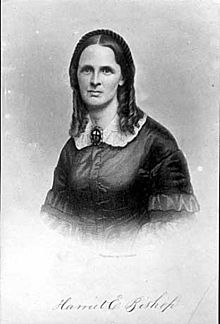Harriet Bishop facts for kids
Quick facts for kids
Harriet Bishop
|
|
|---|---|
 |
|
| Born | Harriet Bishop January 1, 1817 Panton, Vermont, United States |
| Died | August 8, 1883 (aged 66) Saint Paul, Minnesota, U.S. |
| Pen name | Harriet E. Bishop McConkey |
| Occupation | Teacher, writer, activist |
| Alma mater | New York State Normal School |
| Genre | Naturalism, History |
| Subject | Minnesota |
| Notable works | Floral Home Dakota War Whoop Minnesota Then and Now |
| Spouse | John McConkey (divorced) |
| Relatives | Eunice Gibbs Allyn |
Harriet E. Bishop (born January 1, 1817 – died August 8, 1883) was an important American teacher, writer, and activist. She worked for women's suffrage, which means women's right to vote. She also supported the temperance movement, which aimed to reduce alcohol use.
Born in Panton, Vermont, she moved to Saint Paul, Minnesota in 1847. There, she opened Minnesota's very first public school. She also started the first Sunday school in the Minnesota Territory. Harriet Bishop helped create many groups. These included organizations for temperance, women's rights, and other community causes. She was also key in starting the First Baptist Church of Saint Paul.
Bishop loved her new home state of Minnesota. She wrote books about it, like Floral Home, or First Years of Minnesota (1857). Another book was Dakota War Whoop, or Indian Massacres and War in Minnesota of 1862–63 (1863). Harriet Island, near downtown Saint Paul, is named after her.
Contents
Harriet Bishop's Early Life and Teaching Career
Harriet Bishop trained to be a teacher at the Fort Edward Institute. She also studied at the New York State Normal School in Albany, New York. Her teacher there was the famous educator Catherine Beecher. Bishop taught in Essex, New York for about ten years.
Moving to the Western Territories
At this time, there was a great need for teachers in the growing western parts of the United States. Young women in New England often had few teaching jobs. So, a group called the Board of National Popular Education in Cleveland, Ohio started a program. It encouraged young women to move west and open schools.
When Harriet Bishop heard about a chance in the Minnesota Territory, she was very excited. She saw it as a big adventure. Her family and friends tried to stop her, but she later wrote that their arguments only made her more determined. She was inspired by the stories of missionaries Harriet Newell and Ann Judson in Burma.
Starting the First School in Minnesota
On July 19, 1847, Bishop opened her first school. It was in a former blacksmith shop in Saint Paul. This building was a simple "mud walled log hovel." It was covered with bark and sealed with mud. Saint Paul was a small fur trading post back then.
Her first class had only seven students. Only two of them were white. She had a student who spoke French, Dakota, and English. This student helped translate for the classes, which Bishop taught in English.
Less than a year later, she created the Saint Paul Circle of Industry. This group raised money to build a new school. The new building was very important to the community. It was used as a church, a meeting hall, a courtroom, and a place to vote. To help more children, Bishop also founded the Minnesota Women's Seminary in Saint Paul in 1850.
Founding the First Sunday School
Harriet Bishop was a very religious person. Soon after she arrived in Minnesota, she started the first Sunday school there. She is also seen as a key person in starting the ecumenical church movement in Minnesota. This movement brings different Christian churches together.
Harriet Bishop's Activism
Harriet Bishop cared deeply about many public issues. She was especially active in the temperance movement and women's suffrage.
Working for Temperance
She helped organize a group called the Sons of Temperance. In 1877, she became the first organizer of the Minnesota Women's Christian Temperance Union. She worked hard to create new chapters of this group all over the state.
Fighting for Women's Rights
In 1867, she helped start the Ladies Christian Union. This group led the building of the Home to the Friendless. Today, this building is known as Wilder Residence East. Harriet Bishop is also recognized as one of the people who founded the Minnesota Woman Suffrage Association. This group worked to get women the right to vote.
Harriet Bishop's Personal Life
Harriet Bishop was the third daughter of Putnam and Miranda Bishop. They lived in Panton, Vermont. She was engaged to a lawyer in Saint Paul. However, his sister ended the engagement. In 1858, she married John McConkey, who had four children. Their marriage ended in 1867.
After her marriage, Bishop continued her work. She traveled to California in 1873 to give lectures. She returned to Saint Paul in 1875. She kept working as a lecturer, writer, and activist until she passed away. Harriet Bishop died on August 8, 1883. She is buried in Saint Paul's Oakland Cemetery.
Harriet Bishop's Writings
Here are some of the books Harriet Bishop wrote:
- Floral Home; or, First Years of Minnesota, published in New York, 1857
- Dakota War Whoop, or Indian Massacres and War in Minnesota of 1862–63, published in 1863
- Minnesota Then and Now, published in 1869
Harriet Bishop's Legacy
Harriet Bishop left a lasting mark on Minnesota. Harriet Island, which is part of the Harriet Island Regional Park in Saint Paul, is named after her.
A riverboat operating out of Saint Paul is also named the Harriet Bishop. Two elementary schools are named for her as well. These are Harriet Bishop Elementary School in Rochester, Minnesota and in Savage, Minnesota.
See also
 In Spanish: Harriet Bishop para niños
In Spanish: Harriet Bishop para niños

